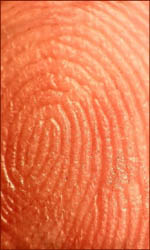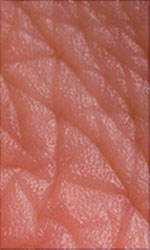
Discover 20 skin facts about hands, fingerprints & dermatoglyphics!

FEBRUARY 16, 2009
Discover 20 skin-facts you didn't know: including hands, fingerprints & dermatoglyphics!
Discover magazine presents a list of remarkable features of the skin of your hand and your fingerprints: about the body's largest organ, dermatoglyphics, skin features and technology.
Author: Sean Markey


• SKIN FACT 1:
Your skin is your body's largest organ, despite what the readers of Maxim think.
• SKIN FACT 2:
An average adult's skin spans 21 square feet, weighs nine pounds, and contains more than 11 miles of blood vessels.
• SKIN FACT 3:
The skin releases as much as three gallons of sweat a day in hot weather. The areas that don't sweat are the nail bed, the margins of the lips, the tip of the penis, and the eardrums.
• SKIN FACT 4:
Ooh, that smell: Body odor comes from a second kind of sweat-a fatty secretion produced by the apocrine sweat glands, found mostly around the armpits, genitals, and anus.
• SKIN FACT 5:
Yum! The odor is caused by bacteria on the skin eating and digesting those fatty compounds.
• SKIN FACT 6:
Did you know that breasts are actually a modified form of the apocrine sweat gland?
• SKIN FACT 7:
Fetuses don't develop dermatoglyphics (the skin ridge patterns in our palms, fingers and soles) until three months' gestation.
• SKIN FACT 8:
Without a trace: Some people never develop fingerprints at all. Two rare genetic defects, known as Naegeli syndrome and dermatopathia pigmentosa reticularis, can leave carriers without any identifying skin ridges on their skin.
• SKIN FACT 9:
Fingerprints increase friction and help grip objects. New World monkeys have similar dermatoglyphic prints on the undersides of their tails, the better to grasp as they swing from branch to branch.
• SKIN FACT 10:
Blowin' in the wind: Globally, dead skin accounts for about a billion tons of dust in the atmosphere. Your skin sheds 50,000 cells every minute.
• SKIN FACT 11:
There are at least five types of receptors in the skin that respond to pain and to touch.
• SKIN FACT 12:
One experiment revealed that Meissner corpuscles-touch receptors that are concentrated in the fingertips and palms, lips and tongue, nipples, penis and clitoris-respond to a pressure of just 20 milligrams, the weight of a fly.
• SKIN FACT 13:
In blind people, the brain's visual cortex is rewired to respond to stimuli received through touch and hearing, so they literally "see" the world by touch and sound.
• SKIN FACT 14:
"In the buff" became synonymous for "nude" in 17th-century England. The term derives from soldiers' leather tunics, or "buffs," whose light brown color apparently resembled an Anglo-Saxon backside.
• SKIN FACT 15:
White skin appeared just 20,000 to 50,000 years ago, as dark-skinned humans migrated to colder climes and lost much of their melanin pigment.
• SKIN FACT 16:
I see very, very white people: Albinos are often cast as movie villains, as seen in The Da Vinci Code, Die Another Day, The Matrix Reloaded, and-inexplicably-the 2001 flick Josie and the Pussycats. Robert Lima of Penn State suggests that people associate pale-skinned albinos with vampires and other mythical creatures of the night.
• SKIN FACT 17:
More than 2,000 people have radio frequency identification chips, or RFID tags, inserted under their skin. The tags can provide access to medical information, log on to computers, or unlock car doors.
• SKIN FACT 18:
Flesh for fantasy: At the Baja Beach club in Barcelona, customers can get an implanted RFID "debit card" and party until their funds are exhausted.
• SKIN FACT 19:
The Cleveland Public Library, Harvard Law School, and Brown University all have books clad in skin stripped from executed criminals or from the poor.
• SKIN FACT 20:
Hopefully, they didn't have to reprint it: One such volume is Andreas Vesalius's pioneering 16th-century work of anatomy, De Humani Corporis Fabrica (On the Fabric of the Human Body).
Source: Discover
Related sources:
The human hand vs. primate hand: understanding our past
Evolutie of the human hand
Sexe differences in the skin & the human hand
A fingerprint characteristic associated with the early prenatal environment
Fingerprints reveal more
Dermatoglyphics: a review
The function of fingerprints: skin ridge friction + a touch filter
More hand technology: the bionic hand
20 Skin facts you didn't know about hands & dermatoglyphics